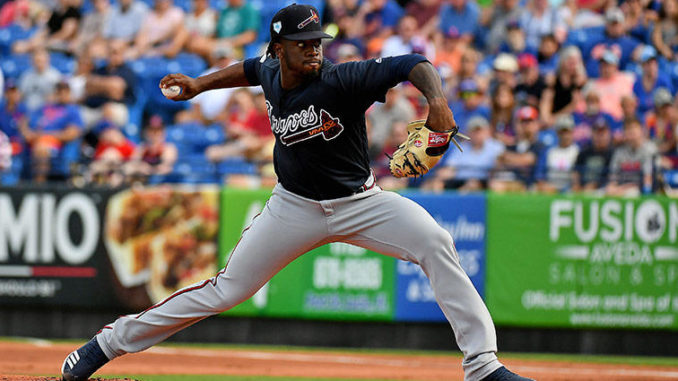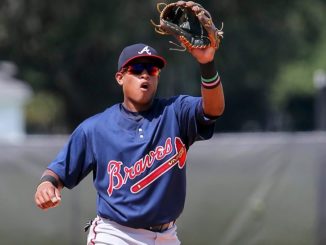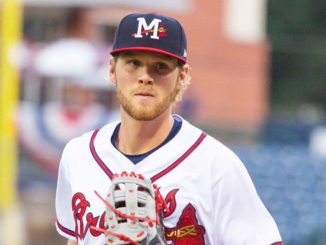
Happy March, Braves fans. By the end of this month, major league baseball games that actually mean something will occur and that my friends is a very good thing.
This is the third composite prospect list I’ve put together. Here is last year’s by way of comparison. This is also not the only composite prospects list out there; there’s also the list put together by Zach Dillard for foxsports.com that uses slightly different methodologies and sources, and was the inspiration for this exercise.
To make this list, I simply average the rankings across different prospect lists, then penalize each player one point (adding to their score) for each list that they were not included. That means that Mike Soroka, included on all 11 lists with an average ranking of 2.36, scored a 2.36. Corbin Clouse showing up on 5 lists with and average rating of 26.00, scores 32.00. I have only included the prospects that showed up at least four times. Where there was a tie, I broke it by the highest ranking on any list.
For this composite ranking, I chose 6 national lists, and 5 lists from sources that specialize in Atlanta Braves coverage. They are as follows:
Baseball America
Baseball Prospectus
ESPN.com (Keith Law)
Fangraphs
MLB Pipeline
Minor League Baseball (John Sickles)
Outfield Fly Rule
Prospects Live
Talking Chop
Tomahawk Take (Benjamin Chase)
Walk-Off Walk
Each of the folks who put these lists together have given this a lot of thought, and all of their write-ups are worth reviewing. I have separated the list into tiers based on their scoring strata.
TIER ONE
1. Mike Soroka, RHP — 2.36
2. Ian Anderson, RHP — 2.73
Despite missing half the regular season with a shoulder impingement, Mike Soroka has not lost the faith of most local prospect watchers, taking the first slot of all but one. Of the national lists, only MLB Pipeline selected Soroka at number one, though he was in the top three of all lists except Keith Law’s, who has consistently ranked Soroka lower than consensus.
Anderson actually had a smaller standard deviation than Soroka, getting two first place nods and not dropping lower than number five anywhere. With most of the players around him likely graduating off the list in 2019, and with his own considerable upside, Anderson is likely the favorite to be the consensus number one prospect on this list next season.
TIER TWO
3. Touki Toussaint, RHP — 4.09
4. Austin Riley, 3B — 4.36
5. Cristian Pache, OF — 4.73
6. Kyle Wright, RHP — 4.73
These four prospects all finished very close to each other, with Pache and Wright not only tying in score, but also in the tiebreaker as both got a number one ranking. Wright however got the lower spot on a list due to getting a lower vote on a list (number 9 on OFR).
Toussaint had the biggest jump up from 2018 of any of the top 10 prospects on the strength of an impressive campaign that saw him finally transfer his always acknowledged top-notch tools into consistent production, enough to carry him from AA Mississippi to throwing playoff baseball for Atlanta by the end of the season. In general Toussaint had more support from the local list-makers than the national ones, and received a first place mark from Jason Woodell at Prospects Live. Toussaint came very close to being the number one choice on the OFR list as well.
Austin Riley takes the title of top position player thanks to his improved defense and move up to AAA and on the cusp of the major leagues. An elevated strikeout rate while at AAA however has kept Riley from shooting higher on some lists, but Baseball America selected him as their number one Braves prospect.
Since I’ve been doing this composite, national writers have consistently had Pache higher than local writers on their lists, but this year there was much more consensus. Pache improved his outlook as an offensive player, though there is still a lively debate on what his offensive ceiling is and the likelihood of his hitting it. Kiley McDaniel of Fangraphs (and formerly of the Braves front office) is the high man on Pache, naming him not only the number one prospect in the organization but also the number 19 prospect in all of baseball.
Keith Law, writing for ESPN.com, selected Wright as his top Braves prospect, noting that Wright is the first player from the 2017 draft to make the major leagues and highlighting a floor of a low-rotation innings-eater. In general the national writers were a little higher on Wright than the local writers, but the standard deviation on Wright across the board was smaller than any other prospect in this tier.
TIER THREE
7. Drew Waters, OF — 7.45
8. Bryse Wilson, RHP — 7.73
9. William Contreras, C — 8.36
Waters was placed as the number 7 prospect on six of the eleven lists, a surprising amount of consensus this deep on the list. There’s been a good bit of debate among fans on who is the better prospect between Waters and fellow centerfielder Cristian Pache; only Baseball America and Talking Chop had Waters ranked higher, but to say that there’s a lot of attention on Waters right now is a bit of an understatement.
Wilson is an interesting case, as there’s strong consensus that he should be on the back end of the top 10 list, but a wide variety of opinions on his ultimate role. Law believes Wilson has the top fastball in the Braves system, and everyone agrees that a separating factor for Wilson is his competitiveness.
Ranking catchers is always an adventure, but there’s absolute agreement that Contreras has separated himself from the other catching prospects in the system after a strong first full minor league season. Ben Chase, long a proponent of the 21-year-old, was the high man on Contreras, placing him at #5 in the organization. Contreras is getting national exposure as well, with Fangraphs putting him in their top 100 prospects in baseball and MLB Pipeline naming him as the number 10 catching prospect in baseball.
TIER FOUR
10. Luiz Gohara, LHP — 11.33
11. Kyle Muller, LHP — 11.36
12. Joey Wentz, LHP — 11.91
13. Kolby Allard, LHP — 13.50
Tier four is the lefty tier.
Gohara is the first prospect on this list not to be placed on all 11 of the lists, mostly because ESPN and Baseball Prospectus mistakenly believed that Gohara no longer has rookie status. Those that did rank Gohara however had him consistently in this area, and Gohara placed tenth in five of the nine lists that placed him, good for the lowest standard deviation of any top 10 prospect.
There’s also a solid consensus that Kyle Muller is just one the outside of the top 10 right now. Seven of the 11 lists had Muller either 11th or 12th, and his superb 2018 season had him jump 7 spots up from last season.
There’s still a good amount of belief in Joey Wentz as well, though he did drop a couple of spots from last year due to missing half of a season with a variety of injuries. Eight of the 11 lists also placed Wentz in the 11/12 area, though more on the 12 side.
Allard is a bit of an in-betweener, but he shares more in common with the tier four group than the tier five. Allard had a strong minor league season but was hit hard in his limited exposure to major league hitters and the feeling overall is that he has substantial work to do to take the next step. John Sickels is still a believer in Allard and ranked him as the number 5 prospect in the system, but Baseball Prospectus left him completely off their top 15, and overall Allard tied for the largest drop on the list over last season.
TIER FIVE
14. Greyson Jenista, OF — 15.00
15. Patrick Weigel, RHP — 16.40
16. Freddy Tarnok, RHP — 16.64
17. Tristan Beck, RHP — 17.40
18. Huascar Ynoa, RHP — 18.80
Tier five has the first two players from the 2018 draft, starting with outfielder Greyson Jenista, of whom there was surprising consensus among the different lists that he fit in the 14/15/16 area.
Despite having UCL replacement surgery in 2017 and not pitching until August in rehab, Patrick Weigel has roughly maintained his standing as a prospect in the opinion of most, dropping only 3 spots since his 12th place finish on the 2017 composite list. That the Braves elected to give a vote of confidence to Weigel by protecting him this offseason with a 40-man roster spot may have helped.
Despite a shaky half season in the Rome rotation to finish out the year, there’s plenty to like about Freddy Tarnok, and that’s reflected by him being the final prospect on this list to also be named on all 11 individual lists.
The second 2018 draftee to appear on the list, Tristan Beck is the kind of high-floor college pitcher that is favored by more risk-adverse prospect pundits, and there was wide consensus about his placement.
Ynoa saw a big jump of 10 spots from last season after demonstrating improved fastball and change-up and securing a 40-man roster spot this off-season.
TIER SIX
19. CJ Alexander, 3B — 21.11
20. Chad Sobotka, RHP — 23.00
21. Alex Jackson, C — 24.50
22. Izzy Wilson, OF — 26.25
23. Trey Riley, RHP — 26.25
24. Jasseel De La Cruz, RHP — 27.33
25. Tucker Davidson, LHP — 27.50
Alexander is almost in a tier by himself. It’s hard not to get excited by a hitter who shows polish and results at the plate in a short season, jumping all the way to advanced-A and more than holding his own. However there is some hesitation on the part of some writers to push him into the top 15 given is relative lack of pedigree and lack of power so far in the pros.
Chad Sobotka makes his debut on the composite list despite being in the Braves organization since 2014 thanks to an overpowering performance out of the bullpen that eventually had him pitching in the playoffs with Atlanta and likely making the club out of spring training.
Alex Jackson tied with Allard for the biggest drop on the list after a disappointing season at the plate. Nevertheless Jackson climbed to the AAA level and seems certain to make his major league debut at some point in 2019 after being placed on the 40-man roster. Local prospect writers tended to be willing to give Jackson the benefit of the doubt slightly more than national ones, though Fangraphs had him at a relatively high 16.
There was more consensus on Izzy Wilson, the young and toolsy outfielder who hasn’t quite put all facets of his game together. Wilson had the lowest standard deviation of any prospect in this tier and it likely could be said that everyone remains intrigued but cautious.
Trey Riley only pitched nine innings after being drafted by the Braves, so his placement here is similar to Wilson’s; the tools are very intriguing, but writers want to see it first.
The same can be said for righty Jasseel De La Cruz, who jumped a whopping 20 spots on this list but remains outside the top 20 (how’s that for system depth?). De La Cruz looked very good in Rome in 2018, but nagging injuries kept him off the field enough to raise some flags.
The last member of this tier is left-hander Tucker Davidson, who’s poor performance early in the 2018 season in his first taste of the Florida State League belied some improvement later in the season. Davidson has looked strong this spring after getting a big league invitation, and I would not be surprised if Davidson was a high climber on next year’s list.
TIER SIX
26. Jefrey Ramos, OF — 29.14
27. Jacob Webb, RHP — 30.00
28. Thomas Burrows, LHP — 31.60
29. Corbin Clouse, LHP — 32.00
30. AJ Graffanino, SS — 32.57
31. Ray-Patrick Didder, SS — 33.57
32. Riley Delgado, SS — 34.20
33. Wes Parsons, RHP — 35.00
34. Justin Dean, OF — 44.25
35. Victor Vodnik, RHP — 45.00
The final tier is an eclectic group of prospects.
Webb, Burrows, Clouse, and Parsons are all relievers knocking on the door of the big leagues.
Graffanino and Delgado share somewhat similar profiles, with Graffanino likely having the edge with the glove and Delgado with the bat. Both profile right now as utility players if they advance to the majors.
Ramos has tremendous raw power but few other tools, so there’s enough risk in his floor that he remains an interesting but lower-ranked prospect for now.
Ray-Patrick Didder is a local prospect writer favorite for his multi-position versatility and video game arm strength, but questions remain about his hit tool.
Justin Dean is a late-round 2018 draftee that showed a good centerfield glove and great speed in the short season.
Last but not least is an intriguing project pitcher, Victor Vodnik. The only high school prospect signed by Atlanta in the 2018 draft, Vodnik already shows the potential for a mid-90s fastball and a sharp slider.




Leave a Reply